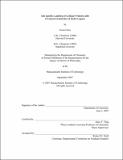| dc.contributor.advisor | Alice Y. Ting. | en_US |
| dc.contributor.author | Chen, Irwin | en_US |
| dc.contributor.other | Massachusetts Institute of Technology. Dept. of Chemistry. | en_US |
| dc.date.accessioned | 2008-05-19T15:00:42Z | |
| dc.date.available | 2008-05-19T15:00:42Z | |
| dc.date.copyright | 2007 | en_US |
| dc.date.issued | 2007 | en_US |
| dc.identifier.uri | http://hdl.handle.net/1721.1/41555 | |
| dc.description | Thesis (Ph. D.)--Massachusetts Institute of Technology, Dept. of Chemistry, 2007. | en_US |
| dc.description | This electronic version was submitted by the student author. The certified thesis is available in the Institute Archives and Special Collections. | en_US |
| dc.description | Vita. | en_US |
| dc.description | Includes bibliographical references. | en_US |
| dc.description.abstract | E. coli biotin ligase (BirA) catalyzes the site-specific ligation of biotin to the lysine within its 15-amino acid peptide substrate (AP). We harnessed the high peptide substrate specificity of BirA to develop a general methodology for site-specific protein labeling with biophysical probes. We synthesized an isosteric ketone analog of biotin and discovered that BirA also ligates it to the AP with similar kinetics while retaining the high peptide specificity of the native reaction. Because ketones are absent from native cell surfaces, recombinant AP-fused cell surface proteins can be tagged with the ketone analog, and then specifically conjugated to hydrazide- or hydroxylamine-functionalized molecules. We demonstrated this two-step protein labeling methodology on purified protein, in the context of mammalian cell lysate, and on epidermal growth factor receptor expressed on the surface of live HeLa cells. Both fluorescein and a benzophenone photoaffinity probe were incorporated, with total labeling times as short as 20 minutes. To develop new protein labeling methodology, we synthesized azide analogs of biotin, but found that BirA did not accept them as substrates. Our efforts to rationally design mutations in the active site to accommodate these analogs met with little success. We thus investigated in vitro compartmentalization as a platform for re-engineering the substrate specificity of BirA through in vitro evolution. | en_US |
| dc.description.abstract | (cont.) Selections did not enrich for BirA mutants that could catalyze ligation of the azide analog to the AP, but instead highlighted the technical difficulties of our in vitro compartmentalization strategy. We used phage display to engineer a new and orthogonal biotin ligase-acceptor peptide pair for site-specific protein labeling. Yeast biotin ligase (yBL) does not biotinylate the AP, but we discovered a new 15-amino acid substrate for yBL, which we call the yeast acceptor peptide (yAP). The yAP is not biotinylated by BirA, and thus we were able to specifically label AP and yAP fusion proteins co-expressed in the same cell with differently colored quantum dots. We fused the yAP to a variety of recombinant proteins and demonstrated biotinylation by yBL at the N-terminus, C-terminus, and within a flexible internal region. yBL is also very sequence-specific, as endogenous proteins on the surface of yeast and HeLa cells are not biotinylated. This new methodology expands the scope of biotin ligase labeling to two-color imaging and yeastbased applications. | en_US |
| dc.description.statementofresponsibility | by Irwin Chen. | en_US |
| dc.format.extent | 2 v. (308 leaves) | en_US |
| dc.language.iso | eng | en_US |
| dc.publisher | Massachusetts Institute of Technology | en_US |
| dc.rights | M.I.T. theses are protected by
copyright. They may be viewed from this source for any purpose, but
reproduction or distribution in any format is prohibited without written
permission. See provided URL for inquiries about permission. | en_US |
| dc.rights.uri | http://dspace.mit.edu/handle/1721.1/7582 | en_US |
| dc.subject | Chemistry. | en_US |
| dc.title | Site-specific labeling of cellular proteins with unnatural substrates of biotin ligases | en_US |
| dc.type | Thesis | en_US |
| dc.description.degree | Ph.D. | en_US |
| dc.contributor.department | Massachusetts Institute of Technology. Department of Chemistry | |
| dc.identifier.oclc | 224015502 | en_US |
